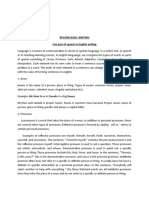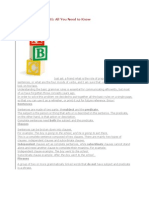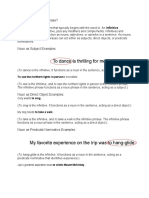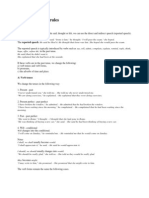DC Verbs
DC Verbs
Uploaded by
kombathulapavan143Copyright:
Available Formats
DC Verbs
DC Verbs
Uploaded by
kombathulapavan143Original Title
Copyright
Available Formats
Share this document
Did you find this document useful?
Is this content inappropriate?
Copyright:
Available Formats
DC Verbs
DC Verbs
Uploaded by
kombathulapavan143Copyright:
Available Formats
DEVAN’S CLASSES | VERBS MATERIAL
What are Verbs?
Verbs are words which convey actions, events and states of people or things.
Function of Verbs
1. What a person or thing does. (Active voice)
Examples: Professor Verma teaches in a university
She usually goes to the U.S. during summer.
2. What is done to a person or a thing. (Passive voice)
Examples: Mr. Sharma was rewarded for his outstanding contribution to the field of English Language
Teaching Vikram was killed in an accident recently.
3. What a person or thing is. (be as a regular/ordinary verb is used to described what a person is)
Examples: He was a school teacher before he became a lecturer.
My sister is a doctor.
Classes of Verbs
There are two classes of verbs:
1. Helping verbs, also known as auxiliary verbs
2. Transitive and intransitive verbs
Helping Verbs or Auxiliary Verbs
Forms of the verb be: is, was, been, am, are, were, being
Forms of the verb have: has, have, had, having
Forms of the verb do: do, does, did, done, doing
Modals or modal auxiliaries: can, could, shall, should, will, would, may, might, dare, ought (Meaning:
should)
Transitive and Intransitive Verbs
1. Transitive verbs: Transit means to move. The action of transitive verbs passes over to the object.
Examples: Rajeev writes short notes in his diary every day.
His wife teaches him how to cook.
2. Intransitive verbs: The action of the intransitive verbs does not pass over to the object. It goes back
to the subject.
Examples: work, smile, sleep. These verbs cannot be changed into passive voice
Look at these examples: He worked very hand the whole day.
She smiled at me.
He slept the whole night peacefully.
His sister cried a lot.
The manager attended on time.
These verbs do not make grammatical, logical and meaningful sentences if changed into passive voice.
Note: Only the transitive verbs can be used in passive voice.
Types of Verbs
1. Finite verbs
2. Non-finite verbs
Finite Verbs
The finite verb has a subject of its own and is limited by the person and the number of the subject.
Transitive and intransitive verbs fall within the category of finite verbs.
Example: Sania is playing tennis now. (In this sentence, Sania is the subject and she is the one
performing the action described by the verb playing.)
Professors were discussing this issue. (In this sentence, professors is the subject and they are performing
the actions described by the verb discussing)
Non-finite Verbs
Non-finite verbs are not limited by the person and the number of any subject. They are used without
mentioning any subject.
Non-finite verbs are of three kinds:
1. Infinitive: The infinitive is the base form of a verb. In English, when we talk about the infinitive, we
are usually referring to the present infinitive, which is the most common. The infinitive has two forms:
• to-infinitive to=+ base verb
• zero infinitive = base verb
The present infinitive base is the verb form we find in a dictionary
Example: He goes to Delhi to see his parents
To-infinitive Zero infinitive
to talk talk
to study study
to have have
to recall recall
2. Participle: A participle is a word formed from a verb which can be used as an adjective of a noun or as
a part the past or present tense, along with a helping verb.
Example: The smoking gun in his hand was a dead giveaway (adjective).
I am studying for UPSC. (a part of the present continuous tense)
My father fixed the broken window. (adjective)
She is crying because the doll has been taken away from her. (a part of the present perfect tense)
The two types of participles are the present participle (ending with-ing) and the past participle (usually
ending in -ed, -d, -t, -en, or -n). Here are some participles being used as adjectives:
Base Form of the Verb The Past Participle The Present Participle
rise risen rising sun
filter filtered filtering
break broken breaking
cook cooked cooking
3. Gerund: The gerund looks exactly the same as a present participle, but it is important to know the
difference between the two. The gerund always has the same function as a noun although it always
looks like a verb.
Examples: Smoking is strictly prohibited in airports.
Hunting tigers is an offence.
Flying makes me nervous.
Brushing your teeth twice in a day is important.
Forms of Verbs
All commonly used verbs (except for the verb be) have three, four or five forms. Here's a table showing
the different forms.
Verbs Work Sing Do Be
(Regular Verb) (Irregular Verb) (Irregular Verb) (Irregular Verb)
Base (V1) Work Sing Do Be
Simple past (V2) Worked Sang Did Was, Were
Past participle (V3) Worked Sung Done Been
Present Participle Working Singing Doing Being
(V4)
3rd person singular Works Sings Does Am, Are, Is
present simple (V5)
Number of forms 4 5 5 8
Syntax Guidelines: Subject-Verb Agreement
In the case of finite verbs, the verb needs to 'agree with the subject. This means that it needs to
correspond to the person (first, second or third), tense (past, present or future) and number of the
subject. Some rules for subject-verb agreement are provided below.
1. When two subjects are joined by and, the verb is plural.
Example: My friend and his father often go abroad.
2. When two singular nouns joined by and refer to the same person or thing, the verb is singular.
Examples: Ravi Ghosh, Director and Marketing Manager of Corps India Ltd, has been arrested. (Here,
Ravi Ghosh is both the director and marketing manager.)
The Chief Executive Officer and Team Leader is on leave today.
Be Careful! Notice that the is used only once when the two nouns refer to the same person or thing.
If the two nouns refer to different persons or things, the article the is used before each noun. In such
case the verb will be in the plural form.
Example: The secretary and the president have been given a warm welcome.
3. If two different singular nouns express one idea, the verb should be in the singular form.
Examples: Bread and milk is good for breakfast. (Here, bread and milk refers to one dish.)
Rice and curry is my favourite dish.
4. When two singular subjects are practically synonymous the verb should be in the singular form.
Examples: The law and order situation in the state is under control.
His name and fame is on the decline.
5. If two singular subjects (combined by and) are preceded by each or every, the verb should be in the
singular.
Example: Every man and woman was present in the office yesterday.
6. When the subjects joined by either...or/neither..nor are of different persons, the verb will agree
with the person and number which is nearest to it. Also, if one subject is plural, then the plural subject
must be placed nearest to the verb.
Examples: Either Ramesh or Suresh has done this mischief
Either the Chief Minister or the Cabinet Ministers are responsible for this problem.
Either you or I am responsible for this mistake.
7. If with, together with, as well as and accompanied by are used to combine two subjects, the verb
agrees with the subject mentioned first.
Examples: The Chief Minister of Telangana, together with his personal secretaries, is invited to this
function.
Prof Radhakrishnan, accompanied by wife and children, is arriving tonight by train.
Sandhya, as well as Priya, is our professor's daughters.
8. If the conjunction and is used instead, the verb would then be plural.
Examples: Sandhya and Priya are our professor's daughters.
You might also like
- Canadian Business English Canadian 7th Edition Guffey Solutions Manual 1Document13 pagesCanadian Business English Canadian 7th Edition Guffey Solutions Manual 1ted100% (61)
- English Grammar 101Document21 pagesEnglish Grammar 101Dharmarao BalagaNo ratings yet
- English Composition NotesDocument83 pagesEnglish Composition Notestapebreanna100% (2)
- ESL - English as a Second Language - Verbs: a QuickStudy Digital Reference GuideFrom EverandESL - English as a Second Language - Verbs: a QuickStudy Digital Reference GuideNo ratings yet
- Constantino Tagalog and Other Philippine LanguagesDocument43 pagesConstantino Tagalog and Other Philippine LanguagesFeed Back Par100% (1)
- Taking The Toeic 2 Answer Key New1Document24 pagesTaking The Toeic 2 Answer Key New1yhenzzeyNo ratings yet
- Verb Dan Adverb NyaDocument13 pagesVerb Dan Adverb NyaMuhamad Wahyu SNo ratings yet
- Paper About Verb (Group 2)Document11 pagesPaper About Verb (Group 2)Money Islife100% (1)
- Morphology Unit4Document25 pagesMorphology Unit4ferasORVNo ratings yet
- The Verb To Be Todo en InglesDocument6 pagesThe Verb To Be Todo en InglesrulandNo ratings yet
- Grammar I Clases 2022 Primera ParteDocument32 pagesGrammar I Clases 2022 Primera ParteGastónNo ratings yet
- VerbDocument25 pagesVerbozzykushNo ratings yet
- Learn Verbs As Part of Speech For Bank 2Document13 pagesLearn Verbs As Part of Speech For Bank 2touseefNo ratings yet
- Meilia Amanda (Verbs)Document5 pagesMeilia Amanda (Verbs)Meilia AmandaNo ratings yet
- Book ChapterDocument8 pagesBook ChapterMisbah AwelNo ratings yet
- 18-Grammar (Tenses) and Vocabulary (Words Often Confuse)Document23 pages18-Grammar (Tenses) and Vocabulary (Words Often Confuse)Rohini SharmaNo ratings yet
- Course Material On Active and PassivevoiceDocument10 pagesCourse Material On Active and PassivevoiceMisbah AwelNo ratings yet
- Parts of SpeechDocument7 pagesParts of Speechnorain_1976No ratings yet
- Verbs in English: Verb) - Auxiliary Verbs Can Add Detail To The Action or Help The Principal Verb (They Are AlsoDocument33 pagesVerbs in English: Verb) - Auxiliary Verbs Can Add Detail To The Action or Help The Principal Verb (They Are AlsoSou SouNo ratings yet
- Use Part of Speech in English WritingDocument4 pagesUse Part of Speech in English WritingtriskaNo ratings yet
- Form) As A Noun (For Example,: Gerund Phrase Running Is My Favorite Activity. Running Marathons Is My Favorite ActivityDocument3 pagesForm) As A Noun (For Example,: Gerund Phrase Running Is My Favorite Activity. Running Marathons Is My Favorite ActivityRoland Mark Rodel LagosNo ratings yet
- Parts of Speech Part 2Document6 pagesParts of Speech Part 2naeemamna259No ratings yet
- English Grammar 101Document10 pagesEnglish Grammar 101Talibovic TalibovNo ratings yet
- Grammar Friska SipayungDocument36 pagesGrammar Friska SipayungLesbra SandyNo ratings yet
- 7 Types of Verb in English, With Examples: PerformdigiDocument6 pages7 Types of Verb in English, With Examples: PerformdigiIsai Garcia FloresNo ratings yet
- английский грамDocument4 pagesанглийский грамСофия СтерховаNo ratings yet
- Created By: Fakri Zia Gina Fitriani Wawan DarmawanDocument27 pagesCreated By: Fakri Zia Gina Fitriani Wawan DarmawanSalma KarimahNo ratings yet
- English Oh ReadDocument115 pagesEnglish Oh Readjoc3lyn_nNo ratings yet
- Grammar 101Document14 pagesGrammar 101Reza Ayah MaharaniNo ratings yet
- What Is An Infinitive Phrase?: Phrase Includes The Infinitive, Plus Any Modifiers and Complements. Infinitives andDocument4 pagesWhat Is An Infinitive Phrase?: Phrase Includes The Infinitive, Plus Any Modifiers and Complements. Infinitives andmadeha aliNo ratings yet
- English Grammar 101Document8 pagesEnglish Grammar 101Chris Hogan100% (1)
- A Nonfinite Verb PHILSDocument5 pagesA Nonfinite Verb PHILSphilipsonNo ratings yet
- TOEIC Grammar GuideDocument38 pagesTOEIC Grammar Guidedinoracastro2295No ratings yet
- Unit 1 Subject Verb AgreementDocument6 pagesUnit 1 Subject Verb AgreementAdeb Mutalib100% (1)
- Module 2Document30 pagesModule 2aashish.v.s2004No ratings yet
- Part of Speech Verb MakalahDocument10 pagesPart of Speech Verb MakalahAeris nya exoNo ratings yet
- Learn English OnlineDocument88 pagesLearn English OnlineKoteswaraRao BandlaNo ratings yet
- Powerpoint Presentation By: Eisha Sabila Dieni Hanifa (2001709/1B2) 2020Document20 pagesPowerpoint Presentation By: Eisha Sabila Dieni Hanifa (2001709/1B2) 2020Eisha Sabila0% (1)
- Adverb + GrammerDocument50 pagesAdverb + GrammerGulfaraz Khan DilzakNo ratings yet
- What Are VerbsDocument168 pagesWhat Are Verbsapi-3827626100% (3)
- TKT Unit 1Document55 pagesTKT Unit 1Jelena MitrovicNo ratings yet
- What Is An Infinitive Phrase?Document4 pagesWhat Is An Infinitive Phrase?madeha aliNo ratings yet
- Bhs InggrisDocument16 pagesBhs InggrisMuhammad WardiNo ratings yet
- Resume Basic Grammer SilaaaaaaaDocument14 pagesResume Basic Grammer SilaaaaaaanurulwasilaturrahmahNo ratings yet
- The Different Types of NounsDocument18 pagesThe Different Types of NounsL.a.ZumárragaNo ratings yet
- Verbs TypesDocument24 pagesVerbs TypesSairamTirumalaiGovindarajuNo ratings yet
- What Is VerbsDocument19 pagesWhat Is VerbsShahrouq Asmeer KhanNo ratings yet
- ELT122-Week 1-3 (pg.14-19)Document38 pagesELT122-Week 1-3 (pg.14-19)Becira LiNo ratings yet
- The Sentence of EnglishDocument16 pagesThe Sentence of EnglishBilal HassanNo ratings yet
- методичка роздрукуватиDocument92 pagesметодичка роздрукуватиСвітлана Олегівна ЧастухінаNo ratings yet
- Grammar - The BasicsDocument78 pagesGrammar - The BasicsAbdul TaiyabNo ratings yet
- (2nd Semester) English Level 2: 1st Assignment - Part of Speech & English TensesDocument15 pages(2nd Semester) English Level 2: 1st Assignment - Part of Speech & English TensesFrancess Deanna RamliNo ratings yet
- Basic English: 1. The Present SimpleDocument11 pagesBasic English: 1. The Present SimpleRaina FemmeNo ratings yet
- Grammar: Book: Chosen Your EnglishDocument7 pagesGrammar: Book: Chosen Your English✬ SHANZA MALIK ✬No ratings yet
- CCS 02 Block 04Document70 pagesCCS 02 Block 04Prakash YashNo ratings yet
- The Eight Parts of Speech: NounsDocument17 pagesThe Eight Parts of Speech: NounsValensia SumampouwNo ratings yet
- The 8 Parts of SpeechDocument6 pagesThe 8 Parts of SpeechGlycel Angela JacintoNo ratings yet
- Parts of A SentenceDocument4 pagesParts of A SentenceFrancisco D. VillaricoNo ratings yet
- Verb Tenses - Group 3Document48 pagesVerb Tenses - Group 3Luz RijoNo ratings yet
- Personal ReviewerDocument41 pagesPersonal ReviewerBea Patricia CutorNo ratings yet
- Comunicate Actions, Feelings and States of BeingDocument11 pagesComunicate Actions, Feelings and States of BeingWilliam VizcainoNo ratings yet
- Road To English BetterDocument65 pagesRoad To English BetterEko Nurhadi SatrioNo ratings yet
- VerbDocument5 pagesVerbRanjith GandhiNo ratings yet
- Pronouns Are Used To Replace Nouns. Pronouns Are Usually Shorter and Quicker Ways of Referring To A Noun To Help Make Sentences Less RepetitiveDocument5 pagesPronouns Are Used To Replace Nouns. Pronouns Are Usually Shorter and Quicker Ways of Referring To A Noun To Help Make Sentences Less RepetitiveAnaNo ratings yet
- Thesis FinalDocument225 pagesThesis FinalMartin Mburu Waweru100% (1)
- Technical Writing Examples 01Document61 pagesTechnical Writing Examples 01asad qureshiNo ratings yet
- FiksDocument21 pagesFiksSri LeginiNo ratings yet
- Unit 1 Passive VoiceDocument9 pagesUnit 1 Passive Voicelight ibobNo ratings yet
- Reported Speech Rules: StatementsDocument6 pagesReported Speech Rules: Statementsmnj_gautamNo ratings yet
- Grammar Have Something DoneDocument7 pagesGrammar Have Something Donetarubi53No ratings yet
- Improving Writing Techniques: Essentials of Business Communication, Asian EditionDocument58 pagesImproving Writing Techniques: Essentials of Business Communication, Asian EditionShan MalikNo ratings yet
- Describing Lost PropertyDocument3 pagesDescribing Lost PropertyagataNo ratings yet
- Unlucky For Some - ReadingDocument5 pagesUnlucky For Some - Readingทัศนีย์ ก่อแก้วNo ratings yet
- Top Notch 2 3rd Edition PDFDocument162 pagesTop Notch 2 3rd Edition PDFComunicación CERNo ratings yet
- PRY 6 English Ist TermDocument17 pagesPRY 6 English Ist TermGideon PaulNo ratings yet
- Literature ReviewDocument7 pagesLiterature ReviewmoshaisNo ratings yet
- Active Passive MCQDocument62 pagesActive Passive MCQAdesh Partap SinghNo ratings yet
- Grade 7 Reviewer 4Document4 pagesGrade 7 Reviewer 4Ma. Ashleen Nicole ColladoNo ratings yet
- Amal Ibrahim Shousha Full Thesis in CdaDocument192 pagesAmal Ibrahim Shousha Full Thesis in Cdaoussama moussaouiNo ratings yet
- Part4 Key Word Transformations OverviewDocument10 pagesPart4 Key Word Transformations OverviewSara Consiglio LpNo ratings yet
- A-Reading: Automation Is The Use of Machines To Reduce The Need For Human Labor. in Other WordsDocument3 pagesA-Reading: Automation Is The Use of Machines To Reduce The Need For Human Labor. in Other WordsYoyoeg OistaNo ratings yet
- Reading From Children's Britannica, Vol 11p 135, 1981 Edn Page 233 PDFDocument7 pagesReading From Children's Britannica, Vol 11p 135, 1981 Edn Page 233 PDFVictory NchekwubeNo ratings yet
- Passive VoiceDocument4 pagesPassive VoiceAlejandro HernandezNo ratings yet
- PDF DocumentDocument3 pagesPDF DocumentSamad HashmiNo ratings yet
- Unit 2. Passive Voice and Modal Verbs - Attempt ReviewDocument26 pagesUnit 2. Passive Voice and Modal Verbs - Attempt ReviewSanti ToralesNo ratings yet
- BSCS Functioanl EnglishDocument5 pagesBSCS Functioanl Englishfizzabasharat44No ratings yet
- Present Perfect Active and PassiveDocument11 pagesPresent Perfect Active and PassiveCaleb ArroyoNo ratings yet
- Reducing Informality in Academic WritingATI PDFDocument3 pagesReducing Informality in Academic WritingATI PDFChristia Abdel HayNo ratings yet
- Nexus CNEXUS CONSTRUCTIONSonstructionsDocument4 pagesNexus CNEXUS CONSTRUCTIONSonstructionsАдемШерифов100% (1)
- at Walden UniversityDocument6 pagesat Walden UniversityLij YaredNo ratings yet

























































































